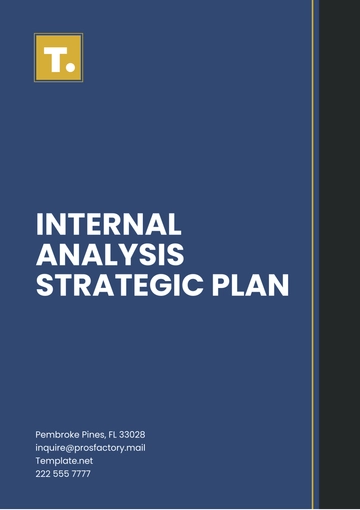Free Financial Services Marketing Strategic Plan

Prepared by: [YOUR NAME]
Date: [DATE]
I. Executive Summary
In the ever-evolving landscape of financial services, establishing a robust and dynamic marketing strategy is essential for maintaining competitiveness and driving growth. This strategic plan outlines the objectives, target markets, and tactical approaches aimed at enhancing brand visibility and customer acquisition.
II. Market Analysis
A. Industry Overview
The financial services industry is undergoing rapid transformation, characterized by technological advancements, regulatory changes, and shifting consumer preferences. This section delves into the current state of the industry, identifying both challenges and opportunities.
B. Competitive Analysis
Understanding the competitive landscape is critical. This involves assessing the key competitors, analyzing their strategies, and identifying their strengths and weaknesses. The following table provides a comparative overview:
Competitor | Market Position | Strengths | Weaknesses |
|---|---|---|---|
Competitor A | Leading | Strong brand loyalty, broad product range | High fees, limited digital presence |
Competitor B | Challenger | Innovative technology, customer service | Limited geographic reach, niche market focus |
III. Target Market Identification
The key to successful financial services marketing is targeting the right audience. Below are the identified segments:
Retail Investors: Individuals looking to manage personal wealth.
Small and Medium Enterprises (SMEs): Businesses seeking financial support and services.
High-Net-Worth Individuals (HNWIs): Clients requiring personalized financial advice.
IV. Marketing Objectives
A clear set of marketing objectives will guide the implementation of our strategy:
Increase brand awareness in key markets by 20% over the next year.
Expand customer base by acquiring 10,000 new clients by the end of Q4.
Enhance customer engagement through improved digital content by 30%.
V. Strategic Initiatives
A. Brand Development
To strengthen brand equity, we will focus on unified messaging across all platforms. This includes a redesign of brand visuals and strategic partnerships.
B. Digital Marketing Campaigns
Leveraging digital platforms is crucial. Initiatives will include:
Search Engine Optimization (SEO) enhancements to increase organic reach.
Targeted social media campaigns focusing on LinkedIn and Instagram.
Implementation of a content marketing strategy with an emphasis on educational material.
C. Customer Relationship Management (CRM)
Enhancing our CRM system will allow for better data utilization, providing personalized experiences. Key activities include:
Integration of AI tools for predictive analytics.
Development of loyalty programs to retain existing clients.
VI. Budget Allocation
A detailed budget allocation ensures resources are directed effectively. The following table provides an overview:
Category | Allocation (USD) | Percentage of Total |
|---|---|---|
Digital Marketing | 500,000 | 40% |
CRM Systems | 300,000 | 24% |
Brand Development | 200,000 | 16% |
Market Research | 150,000 | 12% |
Other Expenses | 100,000 | 8% |
VII. Performance Metrics
Key Performance Indicators (KPIs)
Monitoring the effectiveness of our strategy requires clear KPIs:
Customer Acquisition Cost (CAC)
Return on Marketing Investment (ROMI)
Customer Lifetime Value (CLV)
Net Promoter Score (NPS)
VIII. Conclusion
This strategic plan serves as a comprehensive guide to enhance our market presence and achieve business growth. By focusing on targeted marketing, innovative digital solutions, and strong customer relationships, we aim to drive success in the competitive field of financial services.
- 100% Customizable, free editor
- Access 1 Million+ Templates, photo’s & graphics
- Download or share as a template
- Click and replace photos, graphics, text, backgrounds
- Resize, crop, AI write & more
- Access advanced editor





























